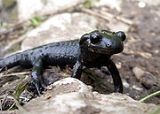
Salamandroidea
Encyclopedia
Salamandroidea is a suborder of salamander
s, referred to as advanced salamanders. The members of the suborder are found worldwide except for Antarctica, Southern Sahara
, and Oceania
. They differ from suborder Cryptobranchoidea
as their angular and prearticular bones in their lower jaw are fused and all members are internal fertilizers
. The female is fertilized via a spermatophore
, a sperm-containing cap that is placed by the male in her cloaca
. The cloaca stores the sperm via a spermathecae until it they are needed on oviposition
.
Salamander
Salamander is a common name of approximately 500 species of amphibians. They are typically characterized by a superficially lizard-like appearance, with their slender bodies, short noses, and long tails. All known fossils and extinct species fall under the order Caudata, while sometimes the extant...
s, referred to as advanced salamanders. The members of the suborder are found worldwide except for Antarctica, Southern Sahara
Sahara
The Sahara is the world's second largest desert, after Antarctica. At over , it covers most of Northern Africa, making it almost as large as Europe or the United States. The Sahara stretches from the Red Sea, including parts of the Mediterranean coasts, to the outskirts of the Atlantic Ocean...
, and Oceania
Oceania
Oceania is a region centered on the islands of the tropical Pacific Ocean. Conceptions of what constitutes Oceania range from the coral atolls and volcanic islands of the South Pacific to the entire insular region between Asia and the Americas, including Australasia and the Malay Archipelago...
. They differ from suborder Cryptobranchoidea
Cryptobranchoidea
Cryptobranchoidea is a suborder of salamanders found in the eastern United States, China, and Japan. They are known as primitive salamanders, in contrast to Salamandroidea, or advanced salamander....
as their angular and prearticular bones in their lower jaw are fused and all members are internal fertilizers
Internal fertilization
In mammals, internal fertilization is done through copulation, which involves the insertion of the penis into the vagina. Some other higher vertebrate animals reproduce internally, but their fertilization is cloacal.The union of spermatozoa of the parent organism. At some point, the growing egg or...
. The female is fertilized via a spermatophore
Spermatophore
A spermatophore or sperm ampulla is a capsule or mass created by males of various animal species, containing spermatozoa and transferred in entirety to the female's ovipore during copulation...
, a sperm-containing cap that is placed by the male in her cloaca
Cloaca
In zoological anatomy, a cloaca is the posterior opening that serves as the only such opening for the intestinal, reproductive, and urinary tracts of certain animal species...
. The cloaca stores the sperm via a spermathecae until it they are needed on oviposition
Oviposition
Oviposition is the process of laying eggs by oviparous animals.Some arthropods, for example, lay their eggs with an organ called the ovipositor.Fish , amphibians, reptiles, birds and monetremata also lay eggs....
.

